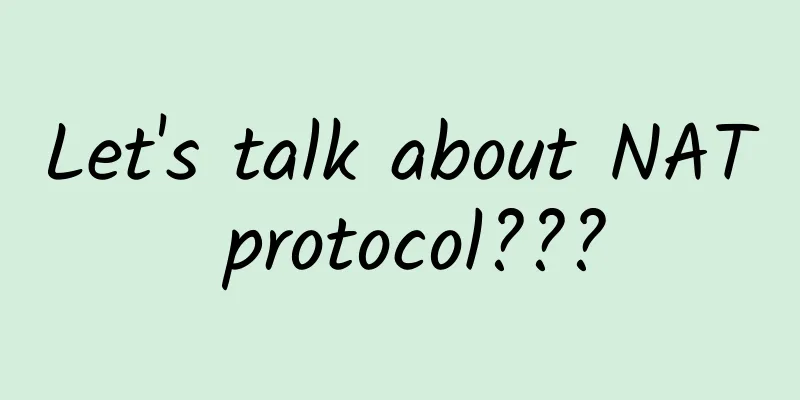Detailed explanation of HTTP protocol security-related headers

|
HTTP security headers are a fundamental part of website security. The HTTP protocol has many security policies that can enhance website security and reduce user attacks. Deploying these security headers helps protect your website from XSS, code injection, and clickjacking. When a user accesses a site through a browser, the server responds with HTTP response headers. These headers tell the browser how to communicate with the site. They contain metadata about the website. You can use this information to summarize the entire communication and improve security. This article will introduce the HTTP protocol security-related headers one by one. 1. Force the use of https transmission, HTTP Strict Transport Security (HSTS) In various hijacked ads + multiple jump network environments, this phenomenon can be effectively alleviated. It can also be used to avoid downgrading from https to http attacks (SSL Strip) The server sets the response header: Strict-Transport-Security: max-age=31536000 ; includeSubDomains to enable After a website (such as Baidu) enables this policy and it is within the validity period, when a user enters baidu.com in the browser address bar, the browser will not go through the process: baidu.com--->http://www.baidu.com--->https://www.baidu.com; instead, it will directly access https://www.baidu.com This policy only applies to ports 80 and 443. Some websites are not fully https, such as pictures. After all, using https requires higher server performance, and man-in-the-middle attacks can still modify the pictures users see. 2. Security Policy (CSP) The HTTP Content Security Policy response header provides a sense of control to website administrators by giving them the ability to restrict the resources that users are allowed to load within their site. In other words, you can whitelist the content sources for your site. Content Security Policy prevents cross-site scripting and other code injection attacks. While it doesn't completely eliminate the possibility of them, it does minimize the damage. Most major browsers support CSP, so compatibility isn't a problem.
3. Cross-site XSS protection, X-XSS-Protection Enable XSS protection on the browser side to reduce the harm of reflected XSS to users (enabled by default in Chrome browser) Server configuration response header:
4. Prevent websites from being nested, X-Frame-Options The website is nested, and attacks such as clickhijacking may occur Server configuration response header:
Because X-Frame-Options only detects the relationship with the top window, if there are multiple layers of nested victim{hacker{victim, it can be bypassed. In addition, the main page can listen to the onBeforeUnload event to cancel the iframe jump; the iframe's sandbox attribute can disable the j in the iframe Therefore, it is necessary to cooperate with the csp rule Content-Security-Policy: frame-ancestors 'self'; 5. Configure multiple security policies, Content-Security-Policy You can define many security policies, script-src, frame-src, referrer, etc. Server configuration response header: Content-Security-Policy: script-src 'self'
6. Response content detection, X-Content-Type-Options Some servers do not set content-type in response content, and the browser will automatically detect the content type (MIME self-identification), which may cause encoding-related security issues (IE and Chrome will ignore content-type and guess the web page format, encoding, etc., which may cause IE's utf-7 xss bypass bug) Server configuration response header: X-Content-Type-Options: nosniff
As the times progress and develop, our lives are increasingly inseparable from the Internet. It can be said that the Internet carries most of our lives, and it will be exposed to criminals if we are not careful. The process of deploying SSL certificates for websites is unstoppable. Digital Security Times recommends that webmasters or corporate website managers deploy appropriate SSL certificates for their websites as soon as possible. |
<<: GSMA: China is expected to have 460 million 5G connections by the end of 2025
>>: WiFi will be replaced in the future, what do you think?
Recommend
Really "understand" the gameplay of HTTP protocol body
We have discussed the characteristics of HTTP and...
China's new breakthrough in optical communication research: one optical fiber can support 13.5 billion people talking at the same time
[[182609]] The first 560Tb/s ultra-large capacity...
Ministry of Industry and Information Technology: Improve 5G service quality and strictly adhere to four marketing red lines
[[380517]] On February 3, the Ministry of Industr...
Operators' operating data in April: 5G package users increased by 21.16 million, totaling about 870 million
The three major operators released their operatin...
Virtono opens new San Jose data center: KVM annual payment starts at 11.21 euros, 40% off for monthly payment
I received an email from Virtono, in which the me...
Master the knowledge of optical modules in one article and become a necessary skill for network engineers
In this era of information explosion, data transm...
Riverbed Redefines APM, Helps Enterprises Promote Digital Transformation
[51CTO.com original article] It is obvious that d...
IDC: 5G commercialization will greatly benefit the manufacturing industry
The issuance of 5G licenses in China has greatly ...
The SD-WAN track has changed. When will the dragon trainer appear?
In an environment where cloud computing, mobile a...
LOCVPS launches 1Gbps port VPS in Hong Kong, 20% discount, monthly payment starts from 36 yuan
LOCVPS launched a 1Gbps port Hong Kong VPS host b...
Cloud Native, the Golden Age of Developers
[[419048]] This is the best time for developers. ...
my country has built the world's largest 4G network
[[181278]] On January 6, the Ministry of Science ...
At the Huawei Maimang 8 launch event, He Gang of Huawei said that the greater the challenge, the greater the achievement
At the launch of Huawei Maimang 8 mobile phone, t...
The 5G concept is very popular, but why is there no progress in the construction of public WiFi?
Since 2015, the country has begun to continuously...
Computing power network has become a new engine for digital development. How can operators make use of it?
At present, the digital economy has become the to...









